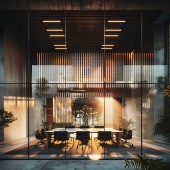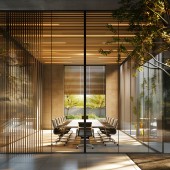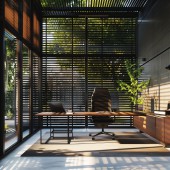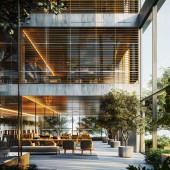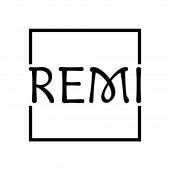Lakeside Workspace Office by Hamidreza Khademi and Mina G. Jahromi |
Home > Winners > #160495 |
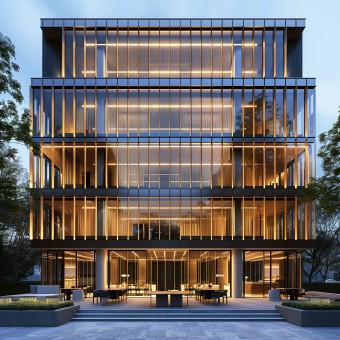 |
|
||||
| DESIGN DETAILS | |||||
| DESIGN NAME: Lakeside Workspace PRIMARY FUNCTION: Office INSPIRATION: The Lakeside Office design had been a remarkable fusion of contemporary architecture and environmental consciousness. Its most notable feature had been its visual connection with the surrounding natural environs, notably the breathtaking lakeside setting. The design integrated the pre-existing southern building, creating a harmonious union of old and new elements. Furthermore, green roof space on the third and fourth floors constituted an idyllic outdoor retreat, prioritizing employee well-being. UNIQUE PROPERTIES / PROJECT DESCRIPTION: The inspiration behind the Lakeside Office design stemmed from a profound desire to establish a harmonious coexistence between the built environment and the natural landscape. By seamlessly integrating the office building with its stunning lakeside setting, the architects sought to create a space that fostered productivity and promoted employee well-being through a direct connection with nature. OPERATION / FLOW / INTERACTION: The Lakeside Office promoted seamless interaction between the built environment and nature. Green roof spaces on the third and fourth floors served as idyllic outdoor retreats, encouraging employees to rejuvenate amidst natural surroundings. The layout had a maximized visual connection with the lakeside setting, fostering tranquility and inspiration. Vertical louvers on the facade enabled effective sunlight control for optimal indoor lighting and energy efficiency. PROJECT DURATION AND LOCATION: The Lakeside Office project had been conceptualized and designed in 2021. It had been a concept design in Karlsruhe, Germany. FITS BEST INTO CATEGORY: Architecture, Building and Structure Design |
PRODUCTION / REALIZATION TECHNOLOGY: The Lakeside Office employed a minimalist material palette comprising concrete, glass, and wood. This thoughtful selection contributed to the contemporary and sleek aesthetic while addressing the region's diverse climatic challenges. The design incorporated a robust foundation to withstand prevailing weather conditions, ensuring structural integrity and longevity. Additionally, vertical louvers on the facade provided functional benefits such as sunlight control and energy efficiency. SPECIFICATIONS / TECHNICAL PROPERTIES: The Lakeside Office encompassed a total area of 4,800 square meters. The building featured a parking lot on the ground level, ensuring optimal accessibility while navigating the site's topographical limitations. The design incorporated vertical louvers on the facade, providing functional benefits such as sunlight control and energy efficiency. The materials used in construction, including concrete, glass, and metal, contributed to the contemporary aesthetic and addressed the region's diverse climatic challenges. TAGS: Lakeside, Office, Nature, Biophilic Design, Green Architecture, Sustainable, Contemporary, Vertical Louvers, Productivity, Well-being, Harmony, Integration, Visual Connection, Outdoor Retreat, Energy Efficiency RESEARCH ABSTRACT: The research for the Lakeside Office design focused on exploring the synergy between contemporary office spaces and their natural surroundings. The primary objective had been to create a workplace that promoted productivity and enhanced employee well-being through a harmonious connection with nature. The methodology involved site analysis, studying biophilic design principles, and examining the impact of natural elements on human psychology and productivity. Data collection included on-site observations, interviews with potential occupants, and literature analysis. The research tools utilized encompassed 3D modeling software, rendering applications, and virtual reality simulations. The results highlighted the positive impact of incorporating natural elements on employee satisfaction, concentration, and well-being. The insights influenced the design decisions, integrating features like the green roof space and strategic sunlight control. CHALLENGE: A significant challenge had been striking a balance between functional office requirements and integrating natural elements. The site's topography and weather conditions had posed obstacles, necessitating robust structural elements and strategic material selection. Ensuring optimal accessibility while preserving the visual connection with the lakeside setting required careful consideration of the building's siting and layout. Overcoming these challenges involved extensive research, innovative design solutions, and a deep understanding of the interplay between architecture, nature, and human psychology. ADDED DATE: 2024-03-06 07:59:11 TEAM MEMBERS (1) : Hamidreza Khademi – Mina Ghanaatian Jahromi – Saeid GhanaatianJahromi IMAGE CREDITS: Hamidreza Khademi – Mina Ghanaatian Jahromi – Saeid GhanaatianJahromi |
||||
| Visit the following page to learn more: https://issuu.com/hrkh/docs/portfolio | |||||
| AWARD DETAILS | |
 |
Lakeside Workspace Office by Hamidreza Khademi and Mina G. Jahromi is Winner in Architecture, Building and Structure Design Category, 2023 - 2024.· Read the interview with designer Hamidreza Khademi and Mina G. Jahromi for design Lakeside Workspace here.· Press Members: Click here to request a exclusive interview about Lakeside Workspace Office from Hamidreza Khademi and Mina G. Jahromi. · Click here to view the profile and other works by Hamidreza Khademi and Mina G. Jahromi. |
| SOCIAL |
| + Add to Likes / Favorites | Send to My Email | Comment | Testimonials | View Press-Release | Press Kit |
Did you like Hamidreza Khademi and Mina G. Jahromi's Architecture Design?
You will most likely enjoy other award winning architecture design as well.
Click here to view more Award Winning Architecture Design.


